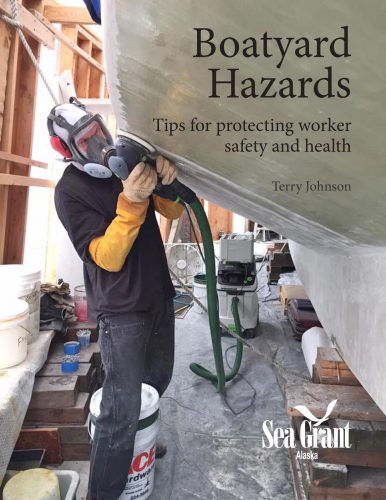New handbook on boatyard hazards aims to improve safety
September 12, 2019
Paula Dobbyn
907-274-9698

Building, repairing and maintaining vessels can be hazardous work. The rate of injury and illness on ships and in boatyards is more than double those of construction and general industry, according to federal officials.
Alaska Sea Grant has a new, online booklet aimed at making boatyards safer by explaining the risks and recommending ways that boat owners and builders, boatyard employees, technicians and others can protect themselves.
“Boatyard Hazards – Tips for Protecting Worker Safety and Health” is not a comprehensive safety and health manual. Rather, it’s an easy-to-read, 16-page resource with information on:
● Who the regulatory authorities are who oversee boatyard safety and health
● How to conduct a hazard analysis and draft a set of best practices
● How to identify types of injury and health risks associated with boatyard work
● Understanding preventive measures for a range of risks
● Selection and use of personal protective equipment
● Reading and interpreting a material safety data sheet
● Overall tips for staying safe
Terry Johnson, retired Alaska Sea Grant Marine Advisory agent and emeritus professor at the University of Alaska Fairbanks, authored the manual, which is available as a free download from the Alaska Sea Grant website. An experienced mariner, Johnson said the guide book resulted from discussions he had with representatives of the National Institute for Occupational Safety and Health and the Alaska Marine Safety Education Association. They told Johnson that boat owners, boatyard employees and many others could benefit from a clear, concise handbook explaining hazards specific to their workplace and how to minimize risk.
“Some excellent books published by government and research agencies address specific issues of boatyard health and safety in detail, but most boatyard workers don't have time to read them. This booklet is a handy reference and a worker can read through it in just a few minutes,” Johnson said.
The author noted that he has been working on boats since the mid-1970s and only became aware of the toxic and hazardous materials he had been exposed to in recent years.
“Professionals in the boat building and repair trades should be trained to recognize and avoid these threats. But boat owners, crew members, and boatyard recent hires may not have all the knowledge they need to avoid sickness, injury and death. That’s what makes this handbook so valuable,” said Jerry Dzugan, AMSEA executive director.
ADDITIONAL CONTACTS: Terry Johnson,907-887-3739, inconnu@ak.net. Jerry Dzugan, 907-747-3287, director@amsea.org.
ON THE WEB: alaskaseagrant.org


